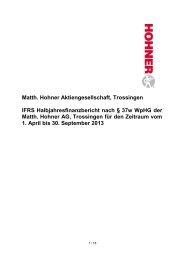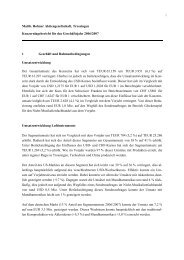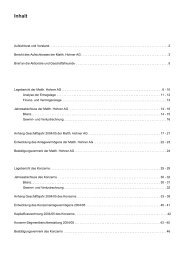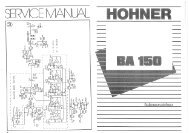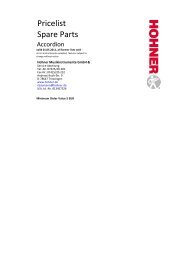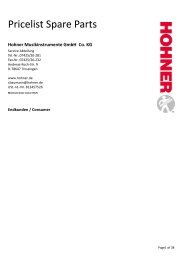Matth. Hohner AG
Matth. Hohner AG
Matth. Hohner AG
You also want an ePaper? Increase the reach of your titles
YUMPU automatically turns print PDFs into web optimized ePapers that Google loves.
Notes to the Consolidated Financial Statements for Business Year 2010/2011<br />
Sensitivity analysis for foreign exchange risks<br />
In order to analyze foreign exchange risks, the Group performs a sensitivity analysis. In the process the<br />
changes of +10 % and -10 % in foreign exchange rates are simulated and effects on material costs and net<br />
yield are investigated. The simulation is performed for USD, CHF and JPY. For the financial year 2010/2011 the<br />
analysis revealed the following risks affecting the annual result:<br />
Währung<br />
Average exchange rate<br />
for March 31, 2011<br />
Changes in results due to<br />
an exchange rate of<br />
-10 % (TEUR)<br />
Changes in results with<br />
an exchange rate of<br />
+10 % (TEUR)<br />
USD 1.3225 -240 +196<br />
JPY (exchange rate for<br />
December 2010)<br />
116.24 -232 +190<br />
CHF 1.3881 -24 +20<br />
Total -496 +405<br />
Changes in equity correspond to the changes in consolidated net income for the year.<br />
To hedge against interest rate risks, resulting from changes in the level of interest rates for existing liabilities<br />
to banks, there are long-term interest rate arrangements for domestic bank loans eliminating the interest rate<br />
risk. Due to fixed rates of interest as well as interest rate swaps for bank loans with variable interest rates,<br />
there is currently no need to perform sensitivity analysis.<br />
Fair value<br />
The group financial instruments not accounted for at fair value primarily consist of cash equivalents, trade<br />
receivables, other receivables, trade payables, other liabilities, overdraft facilities, and long-term loans.<br />
The carrying amount of cash equivalents and the overdraft facilities approximates fair value. The carrying<br />
amount of receivables and payables based on historical cost and subject to normal trade credit terms also<br />
approximates fair value due to the high liquidity of the instruments.<br />
The fair value of non-current liabilities is based on the currently available interest rates for borrowing with the<br />
same maturity and credit-standing profile. At present the fair value of borrowing corresponds closely to the<br />
net carrying amount.<br />
Depending on their fair value on the balance sheet date, derivative financial instruments are reported<br />
separately on the assets side of the balance sheet (positive fair value) or on the liabilities side of the balance<br />
sheet (negative fair value) respectively. Effective cash flow hedges are recognized directly in equity; otherwise<br />
derivative financial instruments are posted to income.<br />
Book values and fair values of financial instruments<br />
The table below shows the reconciliation of the book values shown in the balance sheet and the IFRS<br />
7-categories and IAS 39-valuation categories respectively, subdivided into recognition of financial instruments<br />
carried at amortized cost and financial instruments valued at their fair value. The fair value of a financial<br />
instrument is defined as the price a third party would be willing to pay for taking over the rights and duties<br />
connected with that financial instrument.<br />
Notes to the CoNsolidated FiNaNCial statemeNts Notes to the CoNsolidated FiNaNCial statemeNts<br />
109



